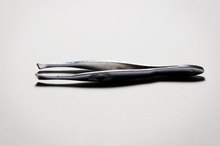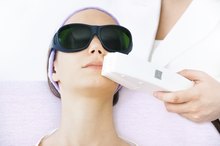Removing an Ingrown Hair on the Face
An ingrown hair often occurs as a result of shaving. The hair is cut with a razor, and as it begins to grow back it curls inside the hair follicle at a different angle. The hair gets trapped beneath the skin 1. A common sign of an ingrown hair is a small bump that is red or pink and tender to touch. Removing an ingrown hair is a simple process but can be painful and could lead to further infection and scarring. Remove an ingrown hair from the face only if absolutely necessary; for example, for an upcoming special occasion or event. An ingrown hair will naturally diminish in most cases within one or two weeks.
Tweezing
Remove the ingrown hair using a set of tweezers. Dip tweezers into rubbing alcohol. Wipe all parts of the tweezers clean, using a cotton ball soaked in the alcohol. The hair can only be removed if the tip is visible. Use a magnifying mirror to identify the hair if it cannot be seen with the naked eye. Grip the hair with the tweezer tip and quickly pull. Do not attempt this repeatedly as the skin will become irritated. If the hair cannot be located, try again the next day. Apply a hot compress to draw out any pus or bacteria still present.
- Remove the ingrown hair using a set of tweezers.
- Use a magnifying mirror to identify the hair if it cannot be seen with the naked eye.
Laser Hair Removal
How to Stop Body Hair Growth in Men
Learn More
A laser can be used to neutralized the hair follicle, killing the hair growing inside the skin. The laser gives a quick zap to the area that feels similar to a rubber band being snapped on the skin. This treatment is recommended for people who suffer from ingrown hairs on a regular basis.
Allow Hair to Grow
Most ingrown hairs will naturally heal themselves and fall out within one week of the hair follicle becoming infected.
Related Articles
References
- Healthy Skin Care
- University of Chicago Medical Center
- TeensHealth from Nemours. Hair removal. Updated August 2016.
- National Organization for Rare Disorders. Trichotillomania.
- NIH MedlinePlus. Depilatory poisoning. Updated April 9. 2020.
- Michigan Medicine. Electrolysis for removing hair. Updated October 30, 2019.
- American Academy of Dermatology. Laser hair removal: FAQs.
- USFDA. Vaniqa™. Updated July 27, 2000.
- Hamzavi I, Tan E, Shapiro J, Lui H. A randomized bilateral vehicle-controlled study of eflornithine cream combined with laser treatment versus laser treatment alone for facial hirsutism in women. J Am Acad Dermatol. 2007;57(1):54-9. doi:10.1016/j.jaad.2006.09.025
- Hamzavi, I., Tan, E., Shapiro, J., Lui, H. (2007). A randomized bilateral vehicle-controlled study of eflornithine cream combined with laser treatment versus laser treatment alone for facial hirsutism in women. J Am Acad Dermatol, Jul, 57, 1, 54-9.
- Wanitphakdeedecha, R., Alster, T.S. (2008). Physical means of treating unwanted hair. Dermatol Ther, Sep-Oct, 21, 5, 392-401.
Writer Bio
Julie Hampton has worked as a professional freelance writer since 1999 for various newspapers and websites including "The Florida Sun" and "Pensacola News Journal." She served in the U.S. Army as a combat medic and nurse for over six years and recently worked as the Community Relations Director for a health center. Hampton studied journalism and communications at the University of West Florida.








